Ch 8 soc. envt.
Download as ppt, pdf0 likes387 views
The document discusses several aspects of business and society including: 1) Business is a social institution that has broad influence on how people live and work together. 2) Culture, which includes both material and non-material elements, influences business practices. 3) Differences in language, religion, and other social/cultural factors present challenges but also opportunities for business.
1 of 17
Downloaded 11 times
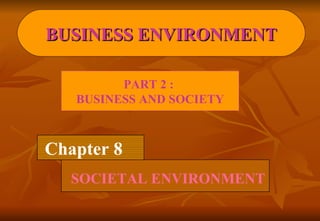
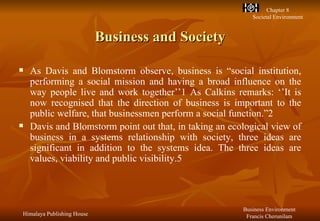
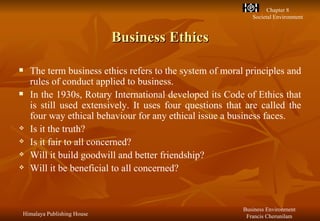
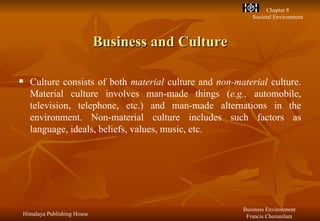


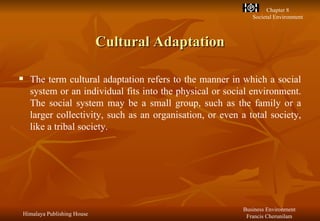



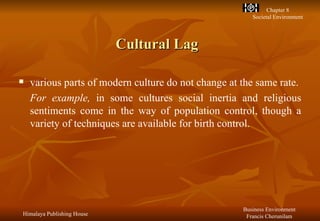

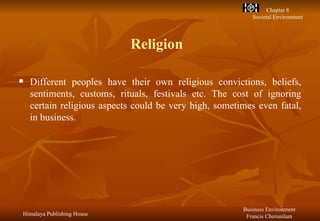

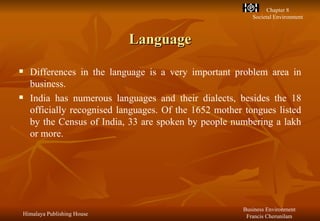

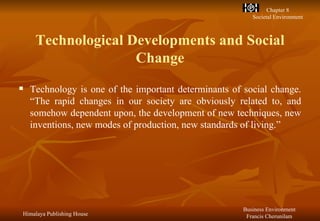
Ad
Recommended
Culture and its differences ppt done
Culture and its differences ppt doneNUML lahore
╠²
This document discusses the key elements of culture, including values, norms, social structure, religion, language, and education. It defines culture as a system of shared values and norms that provide a design for living. Key aspects of social structure examined are individualism vs collectivism and social stratification. The document emphasizes that understanding cultural differences is important for international business success and that culture influences competitive advantage and ethics.7 Elements Of Culture
7 Elements Of CultureAlison Kurtz
╠²
There are 7 key elements that define a culture: 1) social organization including families and social classes, 2) customs and traditions, 3) language, 4) arts and literature, 5) religion, 6) forms of government, and 7) economic systems. Cultures can change over time due to technology, environmental changes, new ideas, and the diffusion of customs and ideas between cultures. However, it is important to avoid ethnocentrism and racism when analyzing different cultures.Chapter03
Chapter03ankit.rk
╠²
The document discusses several key aspects of culture, including its definition, development around the world, and common elements. It explores how culture is shaped by dominant ideologies and varies within subgroups. It also examines the social policy issue of bilingual education and debates around language diversity.Presentation on International Business
Presentation on International BusinessSourav Hossain
╠²
This document discusses differences in culture across nations and how they can affect business practices. It defines culture as a system of shared values and norms among a group of people. Values and norms shape a society's folkways, mores, social structure, religion, language, and other elements. Nations often contain multiple cultures, and cultures can span multiple nations. The document examines cultural dimensions like individualism vs collectivism, power distance, uncertainty avoidance, and masculinity vs femininity that influence work-related values and management practices. It stresses the importance of developing cross-cultural literacy to understand these differences and their impact on competitive advantage.Cultural challenges in international business
Cultural challenges in international businessService_supportAssignment
╠²
This document discusses the cultural challenges in international business, particularly focusing on Hofstede's work on culture and the concept of culture shock among expatriates in China. It outlines Hofstede's five dimensions of culture and critiques his theories while highlighting the significant impact of culture shock on the adaptation of expatriates, leading to high failure rates in international assignments. The document emphasizes the necessity for cultural training to mitigate these challenges and improve expatriate success.Culture
CultureMuhammad Israr
╠²
This document defines culture and its key elements and characteristics according to several anthropologists. It states that culture is learned, social, shared, transmissive, continuous, cumulative, and changing. Culture is acquired as part of socialization and varies across societies. The core elements of culture discussed are traits, complexes, patterns, themes, configurations, and ethos. Traits are the smallest cultural units, while ethos represents the central philosophy or ideology of a culture.The Deep Structure Of Cultures
The Deep Structure Of CulturesElly Lin
╠²
The document discusses the deep structures of cultures, which are the most influential social institutions that shape a culture's worldview. It identifies the three main deep structures as family, community (state), and religion. It argues that these deep structures carry a culture's most important beliefs, endure over time, arouse deep feelings, and provide cultural identity. The document then examines how various cultures are influenced by their own histories, focusing on histories of Mexico, Japan, and Islamic civilization.Elements of Culture 2011
Elements of Culture 2011mjesinski
╠²
Culture refers to the way of life of a group of people including their beliefs, customs, and material traits. Cultural anthropology studies cultural variations and how global processes impact local cultures. Cultural diffusion is the spreading of knowledge between cultures, often facilitated by shared languages. A culture's social groups, families, classes, ethnicities, and governments help organize society and meet people's basic needs. Economies determine how cultures produce and obtain goods and services, with market, command, social, and subsistence models. Development levels vary between more developed countries and less developed or developing nations.Cultural differences
Cultural differencesibc-business-strategy
╠²
1. Culture is learned from one's social environment rather than being innate, and refers to shared values and meanings within groups rather than individual behaviors.
2. Key aspects of culture include direct vs indirect communication styles, individualism vs collectivism, uncertainty avoidance, power distance, and short-term vs long-term orientation.
3. Understanding differences in cultural dimensions like context, hierarchy, risk tolerance, and time orientation is important for effective international business and management.Organization of culture
Organization of cultureD├żwood Sh├żhid
╠²
This document defines culture and discusses its key characteristics, types, elements and organization. It also examines concepts like cultural uniformity and variability, ethnocentrism, cultural relativism, sub-cultures, counter-culture, cultural shock and xenocentrism. Culture is defined as the learned behaviors, beliefs, values, and symbols shared by a group. It is transmitted intergenerationally and includes material, intellectual and emotional elements. While cultures share some universal traits, there is also variability between and within societies.What is society
What is societyneliza laurenio
╠²
Society is defined as a group of people involved in persistent social interaction, sharing the same territory and political authority. The document discusses the evolution of different types of societies from hunting and gathering to agricultural to industrial to postindustrial. It also examines kinship systems and how they define relationships through descent and marriage. Key kinship patterns discussed include Iroquois, Crow, Omaha, Eskimo, Hawaiian and Sudanese. The document also addresses social stratification, norms, roles, status and descent groups within societies.Deep Structures of Culture
Deep Structures of CultureUniversity of Calgary, School of Creative and Performing Arts
╠²
The document discusses how culture is shaped by deep structures like social institutions and organizations. It identifies the family, history, and religion as the most enduring social organizations that define and transmit crucial cultural elements. The family teaches members about economics, socialization, values, and performs other key functions in all cultures. However, globalization is impacting traditional family structures worldwide. A culture's history also affects individual perceptions and behaviors and how people relate to other cultures.elements of Culture
elements of Cultureniks884
╠²
Culture encompasses all aspects of a person's way of life, including social organization (like family structures), customs, language, and arts, which help convey beliefs and traditions. Major forms of government include democracies, republics, and dictatorships, reflecting how power and authority are organized in different societies. Economic systems answer fundamental questions about production and distribution, with various systems like traditional, market, and command economies shaping how resources are allocated.2 culture accoding_to_silibus
2 culture accoding_to_silibusNasriyah Adnan
╠²
This document discusses culture and its impact on business. It defines culture and lists its key elements, including attitudes, values, beliefs and practices. It also outlines Hofstede's 5 dimensions of national culture that influence behavior: individualism vs collectivism, power distance, uncertainty avoidance, masculinity vs femininity, and long vs short-term orientation. The document then examines causes of cultural differences between countries and how culture can change over time due to factors like technology, economics and politics. It provides examples of cultural behaviors that affect business and strategies for reconciling international cultural differences, such as cultural awareness and grouping similar countries.Elements of culture josephine manapsal
Elements of culture josephine manapsalprinsesamj
╠²
Culture refers to the shared beliefs, values, behaviors, and objects that form a society's way of life. It includes both material objects and non-material aspects like traditions and knowledge shared between generations. Culture shapes how members of a society perceive the world, determine what is considered good or bad, and structure how they interact with each other through language, norms, and other symbols. Societies provide the context for cultures to be created and shared through patterns of social interaction.Chap003
Chap003guest2e979d
╠²
Culture refers to the shared values and norms of a group of people. It includes both visible elements like language and religion as well as deeper drivers of behavior. A society is shaped by many factors over time like its history, geography, and economic system. Managers must develop cross-cultural literacy to understand how these differences impact work practices and ethics across countries to succeed internationally.7 Traits of Culture
7 Traits of Culturebaloghb
╠²
Culture consists of the shared ways of life of a people, including seven key elements: government which provides common needs and protection; religion which answers life's fundamental questions; customs and traditions which establish accepted behaviors; social organization which divides people into subgroups; arts such as dance, drama, and music; economy concerning resource use to meet needs; and language for communicating thoughts and knowledge both verbally and non-verbally.Culture
CultureMary Queen Bernardo
╠²
This document provides an overview of key concepts in sociological understanding of culture. It discusses culture as consisting of material and symbolic components that are shared and passed down through a group. Key components of symbolic culture discussed include values, norms, language, and symbols. The document also examines cultural diversity, change, and theories for analyzing culture, including structural functionalism and social conflict perspectives. Socialization and its role in cultural transmission across the lifespan is explored.7 elements-of-culture-1204749912100452-5
7 elements-of-culture-1204749912100452-5Anupriya Shaji
╠²
This document defines culture and its key elements. Culture consists of the beliefs, behaviors, and symbols shared by a society. It is learned and influences how people view the world. The main elements of culture discussed are social organization into groups like families and classes, customs and traditions, language, arts and literature, religion, forms of government, and economic systems. Cultures also change over time due to factors like technology, environment, new ideas, and the diffusion of customs between places. The document cautions against ethnocentrism and racism when examining other cultures.802 Culture Presentation
802 Culture PresentationAspenWalker
╠²
The document discusses several key aspects of culture including definitions, theories and models of culture, factors that influence culture, and how libraries can adapt services to changing cultural demographics. It provides definitions of culture from Edward Tylor and outlines common elements of culture. Models of culture are presented including pattern theory, layers of culture with visible/hidden elements, and comparisons of Western vs non-Western worldviews. Factors like globalization, diversity, and multiculturalism are also covered, along with how libraries can track cultural changes and adapt services for different cultural groups.What Is Culture
What Is Cultureahmad bassiouny
╠²
Culture refers to the human ability to classify and communicate experiences symbolically. It includes a society's way of life comprising codes of manners, dress, language, religion, rituals, and systems of belief. Culture consists of four elements passed down through generations: values, norms, institutions, and artifacts. Values are ideas about what seems important, norms are expectations of how people will behave, institutions transmit values and norms, and artifacts derive from a culture's values and norms.Characteristics of culture (slideshare).ppt
Characteristics of culture (slideshare).pptMhyca Macalinao
╠²
Culture is learned through human experience, transmitted across generations through social learning, and helps integrate societies by satisfying basic human needs. It is shared through language and symbols, develops over time to adapt to new environments and experiences, and brings together different customs and traditions to form a cohesive whole. Culture gratifies biological and social needs for food, shelter, protection, and social connection.Cultural change and diversity
Cultural change and diversityNahin Mahfuz Seam
╠²
This document discusses cultural change and diversity. It defines culture and lists its key elements, which include social organization, customs, religion, language, arts, government, and economic systems. The document explains that cultural change occurs through invention, environmental changes, and diffusion between societies. Cultural diversity refers to the variety of cultural differences that exist worldwide or within a society. It is important because it creates richer perspectives, encourages compassion, reflects globalization trends, and opens new market opportunities. In conclusion, all societies have unique cultures that evolve over time, and embracing cultural diversity is important for a sustainable lifestyle.Caribbean Studies Caribbean society and culture
Caribbean Studies Caribbean society and culturecapesociology
╠²
This document discusses key concepts related to Caribbean society and culture. It defines society as a collection of people living in the same area over time and sharing a common purpose. Culture is described as the way of life of a people. The social world comprises groups where people hold multiple memberships and social locations. A brief history is provided of social changes from the Renaissance and Industrial Revolution to the modern Information Society defined by information and communication technologies. Sociology is introduced as the study of society and culture, and their relationship. Different views of social structure are outlined, from the Functionalist view of stability to the Marxist view of economic domination.Making
MakingAnnie Ramos Alpanta
╠²
This document discusses the key components of culture, including communication, cognitive, behavioral, and material aspects. It examines how culture is transmitted through enculturation, acculturation, and assimilation. The document also explores the importance and functions of culture in providing rules for society and developing concepts of identity. It introduces the concept of cultural relativism to explain differences in what is acceptable or unacceptable across societies.Anthro30 7 characteristics of culture
Anthro30 7 characteristics of cultureYvan Gumbao
╠²
Culture is a learned, shared, and dynamic system comprising symbols that shape social behavior, needs, and relationships within a society. It is integrated into social structures and practices that vary across different societies while allowing for diverse gender identities and roles. Culturally, systems adjust over time, responding to internal and external influences, highlighting the adaptability of human societies.Lesson 2 The Local and International Business Environment of the Firm
Lesson 2 The Local and International Business Environment of the FirmGLADS123
╠²
The document provides information about Lesson 2 on the local and international business environment of the firm. It includes activities for students to complete, which focus on defining cultural intelligence and other terms, comparing student answers to textbook definitions, and analyzing Geert Hofstede's cultural dimensions model. Specifically, it discusses power distance and uncertainty avoidance dimensions, comparing characteristics in Western countries versus the Philippines. Students are assigned homework questions to further their understanding of these topics.Mgnt4670 Ch 3 Differences In Culture
Mgnt4670 Ch 3 Differences In Cultureknksmart
╠²
The document discusses differences in culture and how it relates to business. It defines culture as shared values and norms among a group that constitute a design for living. Culture includes both visible and invisible components, with values and norms being deeper components. Different types of norms like folkways and mores are described. Culture is determined by factors like social structure, religion, language, and education. Hofstede's model of cultural dimensions is presented as a framework to analyze differences in individualism/collectivism, power distance, uncertainty avoidance, and masculinity/femininity across cultures. Culture influences business decisions and must be considered to avoid costly mistakes when conducting international business.Business Environment - SBAA3002 - UNIT 2 Final-1.pptx
Business Environment - SBAA3002 - UNIT 2 Final-1.pptxHarish940427
╠²
The document discusses the concept of culture, defining it as a set of accepted norms, values, and behaviors that influence all aspects of business and society. It covers the characteristics, functions, and elements of culture, highlighting its dynamic and learned nature, as well as its transmission from generation to generation. Additionally, it explores corporate culture and its various types, emphasizing the importance of organizational culture in shaping workplace dynamics and employee engagement.Culture ch 3
Culture ch 3Afifahliliyana
╠²
This document discusses cultural differences and how culture impacts business. It defines culture as shared values and norms that guide a society. Key aspects of culture discussed include social structure, religion, language, and values. Differences in individualism vs collectivism and high/low context communication styles across cultures are examined. The document also explores how culture influences the workplace and can change over time. National cultural dimensions like power distance, uncertainty avoidance, and masculinity/femininity are important to understand for business managers operating across borders.More Related Content
What's hot (19)
Cultural differences
Cultural differencesibc-business-strategy
╠²
1. Culture is learned from one's social environment rather than being innate, and refers to shared values and meanings within groups rather than individual behaviors.
2. Key aspects of culture include direct vs indirect communication styles, individualism vs collectivism, uncertainty avoidance, power distance, and short-term vs long-term orientation.
3. Understanding differences in cultural dimensions like context, hierarchy, risk tolerance, and time orientation is important for effective international business and management.Organization of culture
Organization of cultureD├żwood Sh├żhid
╠²
This document defines culture and discusses its key characteristics, types, elements and organization. It also examines concepts like cultural uniformity and variability, ethnocentrism, cultural relativism, sub-cultures, counter-culture, cultural shock and xenocentrism. Culture is defined as the learned behaviors, beliefs, values, and symbols shared by a group. It is transmitted intergenerationally and includes material, intellectual and emotional elements. While cultures share some universal traits, there is also variability between and within societies.What is society
What is societyneliza laurenio
╠²
Society is defined as a group of people involved in persistent social interaction, sharing the same territory and political authority. The document discusses the evolution of different types of societies from hunting and gathering to agricultural to industrial to postindustrial. It also examines kinship systems and how they define relationships through descent and marriage. Key kinship patterns discussed include Iroquois, Crow, Omaha, Eskimo, Hawaiian and Sudanese. The document also addresses social stratification, norms, roles, status and descent groups within societies.Deep Structures of Culture
Deep Structures of CultureUniversity of Calgary, School of Creative and Performing Arts
╠²
The document discusses how culture is shaped by deep structures like social institutions and organizations. It identifies the family, history, and religion as the most enduring social organizations that define and transmit crucial cultural elements. The family teaches members about economics, socialization, values, and performs other key functions in all cultures. However, globalization is impacting traditional family structures worldwide. A culture's history also affects individual perceptions and behaviors and how people relate to other cultures.elements of Culture
elements of Cultureniks884
╠²
Culture encompasses all aspects of a person's way of life, including social organization (like family structures), customs, language, and arts, which help convey beliefs and traditions. Major forms of government include democracies, republics, and dictatorships, reflecting how power and authority are organized in different societies. Economic systems answer fundamental questions about production and distribution, with various systems like traditional, market, and command economies shaping how resources are allocated.2 culture accoding_to_silibus
2 culture accoding_to_silibusNasriyah Adnan
╠²
This document discusses culture and its impact on business. It defines culture and lists its key elements, including attitudes, values, beliefs and practices. It also outlines Hofstede's 5 dimensions of national culture that influence behavior: individualism vs collectivism, power distance, uncertainty avoidance, masculinity vs femininity, and long vs short-term orientation. The document then examines causes of cultural differences between countries and how culture can change over time due to factors like technology, economics and politics. It provides examples of cultural behaviors that affect business and strategies for reconciling international cultural differences, such as cultural awareness and grouping similar countries.Elements of culture josephine manapsal
Elements of culture josephine manapsalprinsesamj
╠²
Culture refers to the shared beliefs, values, behaviors, and objects that form a society's way of life. It includes both material objects and non-material aspects like traditions and knowledge shared between generations. Culture shapes how members of a society perceive the world, determine what is considered good or bad, and structure how they interact with each other through language, norms, and other symbols. Societies provide the context for cultures to be created and shared through patterns of social interaction.Chap003
Chap003guest2e979d
╠²
Culture refers to the shared values and norms of a group of people. It includes both visible elements like language and religion as well as deeper drivers of behavior. A society is shaped by many factors over time like its history, geography, and economic system. Managers must develop cross-cultural literacy to understand how these differences impact work practices and ethics across countries to succeed internationally.7 Traits of Culture
7 Traits of Culturebaloghb
╠²
Culture consists of the shared ways of life of a people, including seven key elements: government which provides common needs and protection; religion which answers life's fundamental questions; customs and traditions which establish accepted behaviors; social organization which divides people into subgroups; arts such as dance, drama, and music; economy concerning resource use to meet needs; and language for communicating thoughts and knowledge both verbally and non-verbally.Culture
CultureMary Queen Bernardo
╠²
This document provides an overview of key concepts in sociological understanding of culture. It discusses culture as consisting of material and symbolic components that are shared and passed down through a group. Key components of symbolic culture discussed include values, norms, language, and symbols. The document also examines cultural diversity, change, and theories for analyzing culture, including structural functionalism and social conflict perspectives. Socialization and its role in cultural transmission across the lifespan is explored.7 elements-of-culture-1204749912100452-5
7 elements-of-culture-1204749912100452-5Anupriya Shaji
╠²
This document defines culture and its key elements. Culture consists of the beliefs, behaviors, and symbols shared by a society. It is learned and influences how people view the world. The main elements of culture discussed are social organization into groups like families and classes, customs and traditions, language, arts and literature, religion, forms of government, and economic systems. Cultures also change over time due to factors like technology, environment, new ideas, and the diffusion of customs between places. The document cautions against ethnocentrism and racism when examining other cultures.802 Culture Presentation
802 Culture PresentationAspenWalker
╠²
The document discusses several key aspects of culture including definitions, theories and models of culture, factors that influence culture, and how libraries can adapt services to changing cultural demographics. It provides definitions of culture from Edward Tylor and outlines common elements of culture. Models of culture are presented including pattern theory, layers of culture with visible/hidden elements, and comparisons of Western vs non-Western worldviews. Factors like globalization, diversity, and multiculturalism are also covered, along with how libraries can track cultural changes and adapt services for different cultural groups.What Is Culture
What Is Cultureahmad bassiouny
╠²
Culture refers to the human ability to classify and communicate experiences symbolically. It includes a society's way of life comprising codes of manners, dress, language, religion, rituals, and systems of belief. Culture consists of four elements passed down through generations: values, norms, institutions, and artifacts. Values are ideas about what seems important, norms are expectations of how people will behave, institutions transmit values and norms, and artifacts derive from a culture's values and norms.Characteristics of culture (slideshare).ppt
Characteristics of culture (slideshare).pptMhyca Macalinao
╠²
Culture is learned through human experience, transmitted across generations through social learning, and helps integrate societies by satisfying basic human needs. It is shared through language and symbols, develops over time to adapt to new environments and experiences, and brings together different customs and traditions to form a cohesive whole. Culture gratifies biological and social needs for food, shelter, protection, and social connection.Cultural change and diversity
Cultural change and diversityNahin Mahfuz Seam
╠²
This document discusses cultural change and diversity. It defines culture and lists its key elements, which include social organization, customs, religion, language, arts, government, and economic systems. The document explains that cultural change occurs through invention, environmental changes, and diffusion between societies. Cultural diversity refers to the variety of cultural differences that exist worldwide or within a society. It is important because it creates richer perspectives, encourages compassion, reflects globalization trends, and opens new market opportunities. In conclusion, all societies have unique cultures that evolve over time, and embracing cultural diversity is important for a sustainable lifestyle.Caribbean Studies Caribbean society and culture
Caribbean Studies Caribbean society and culturecapesociology
╠²
This document discusses key concepts related to Caribbean society and culture. It defines society as a collection of people living in the same area over time and sharing a common purpose. Culture is described as the way of life of a people. The social world comprises groups where people hold multiple memberships and social locations. A brief history is provided of social changes from the Renaissance and Industrial Revolution to the modern Information Society defined by information and communication technologies. Sociology is introduced as the study of society and culture, and their relationship. Different views of social structure are outlined, from the Functionalist view of stability to the Marxist view of economic domination.Making
MakingAnnie Ramos Alpanta
╠²
This document discusses the key components of culture, including communication, cognitive, behavioral, and material aspects. It examines how culture is transmitted through enculturation, acculturation, and assimilation. The document also explores the importance and functions of culture in providing rules for society and developing concepts of identity. It introduces the concept of cultural relativism to explain differences in what is acceptable or unacceptable across societies.Anthro30 7 characteristics of culture
Anthro30 7 characteristics of cultureYvan Gumbao
╠²
Culture is a learned, shared, and dynamic system comprising symbols that shape social behavior, needs, and relationships within a society. It is integrated into social structures and practices that vary across different societies while allowing for diverse gender identities and roles. Culturally, systems adjust over time, responding to internal and external influences, highlighting the adaptability of human societies.Lesson 2 The Local and International Business Environment of the Firm
Lesson 2 The Local and International Business Environment of the FirmGLADS123
╠²
The document provides information about Lesson 2 on the local and international business environment of the firm. It includes activities for students to complete, which focus on defining cultural intelligence and other terms, comparing student answers to textbook definitions, and analyzing Geert Hofstede's cultural dimensions model. Specifically, it discusses power distance and uncertainty avoidance dimensions, comparing characteristics in Western countries versus the Philippines. Students are assigned homework questions to further their understanding of these topics.Similar to Ch 8 soc. envt. (20)
Mgnt4670 Ch 3 Differences In Culture
Mgnt4670 Ch 3 Differences In Cultureknksmart
╠²
The document discusses differences in culture and how it relates to business. It defines culture as shared values and norms among a group that constitute a design for living. Culture includes both visible and invisible components, with values and norms being deeper components. Different types of norms like folkways and mores are described. Culture is determined by factors like social structure, religion, language, and education. Hofstede's model of cultural dimensions is presented as a framework to analyze differences in individualism/collectivism, power distance, uncertainty avoidance, and masculinity/femininity across cultures. Culture influences business decisions and must be considered to avoid costly mistakes when conducting international business.Business Environment - SBAA3002 - UNIT 2 Final-1.pptx
Business Environment - SBAA3002 - UNIT 2 Final-1.pptxHarish940427
╠²
The document discusses the concept of culture, defining it as a set of accepted norms, values, and behaviors that influence all aspects of business and society. It covers the characteristics, functions, and elements of culture, highlighting its dynamic and learned nature, as well as its transmission from generation to generation. Additionally, it explores corporate culture and its various types, emphasizing the importance of organizational culture in shaping workplace dynamics and employee engagement.Culture ch 3
Culture ch 3Afifahliliyana
╠²
This document discusses cultural differences and how culture impacts business. It defines culture as shared values and norms that guide a society. Key aspects of culture discussed include social structure, religion, language, and values. Differences in individualism vs collectivism and high/low context communication styles across cultures are examined. The document also explores how culture influences the workplace and can change over time. National cultural dimensions like power distance, uncertainty avoidance, and masculinity/femininity are important to understand for business managers operating across borders.cultural diversity and multicultural teamwork
cultural diversity and multicultural teamworkJoshuab8
╠²
This document discusses cultural diversity and multicultural teamwork. It begins by defining culture and explaining that culture consists of various learned behaviors and norms that are shared by a group of people. It then discusses different types of culture, including ideal culture (goals of a society), real culture (values actually implemented), material culture (physical objects used to define culture), and non-material culture (nonphysical ideas about culture). The document also outlines basic elements of culture, characteristics of culture, and describes cultural anthropology as the study of human cultural variation. Finally, it discusses how cultural anthropology relates to international business and the importance of understanding cultural differences in a business context.Socio cultural environment
Socio cultural environmentRajThakuri
╠²
The socio-cultural environment in Nepal influences business in several ways. Key factors of the socio-cultural environment that affect Nepalese business include attitudes, beliefs, religion, language, education, and family structure. Religion influences areas like food, dress, and travel. Family structure is predominantly joint and extended, which can discourage individual incentive. Socio-cultural values shape management practices, work attitudes, entrepreneurship, and change management in Nepalese business. Management style tends to be autocratic and professionalism is lacking. Risk-taking is also limited due to socio-cultural influences.Culture
CultureKaushik Deb
╠²
The document discusses the complexity of culture, defining it as learned, interrelated, and shared, with multiple layers such as national, business, and company cultures that influence individual behavior. It highlights elements of culture, including language, technology, social institutions, education, aesthetics, and religion, which play a critical role in international marketing. Using McDonald's entry into India as a case study, it illustrates the challenges of adapting to local cultural norms while navigating ethical dilemmas in global business contexts.culture.pptx
culture.pptxAnamikaShakya4
╠²
Culture is a complex concept that refers to the shared beliefs, values, customs, and behaviors of a society or group. It includes both material and non-material aspects that are learned and transmitted between generations. Some key aspects of culture discussed in the document include definitions of culture, characteristics of culture, elements of culture such as symbols and values, and concepts like cultural universals, cultural lag and lead, global culture, and cultural imperialism.SOCIAL & CULTURAL ENVIRONMENT
SOCIAL & CULTURAL ENVIRONMENTKarishmaShetty16
╠²
The document discusses the social and cultural environment that businesses operate within. It defines the social environment as consisting of a society's beliefs, customs, and behaviors. The cultural environment refers to the prevailing norms and values that guide behavior. Businesses must understand and adapt to their external social and cultural environments in order to be successful. They must also carefully manage their internal social environments by building a positive organizational culture. The document outlines the various responsibilities businesses have towards shareholders, government, customers, employees, and society. It discusses the importance of ethics, social auditing, and corporate governance for businesses.2-culture and its elements.ppt cross cultural understanding
2-culture and its elements.ppt cross cultural understandinginternationaloffice11
╠²
2-culture and its elements.ppt cross cultural understanding BUSINESS ENVIRONMENT NOTES FOR COMMERCE STUDENTS
BUSINESS ENVIRONMENT NOTES FOR COMMERCE STUDENTSramidhavsclas
╠²
This document provides an overview of environmental analysis and corporate social responsibility in business. It defines environmental analysis as the process of scanning, monitoring, and evaluating external factors that may impact a business. It also defines corporate social responsibility as a commitment by businesses to act ethically and contribute to economic development while improving lives. The document then discusses various components of the socio-cultural environment that influence business, including social norms, gender roles, family structure, and education. It also covers macroeconomic parameters like gross domestic product, per capita income, population trends, and fiscal policy that shape the economic environment for businesses.culture
cultureChristian Villanueva
╠²
Culture refers to the shared traditions, values, and ways of life that unite a group of people. It includes tangible aspects like language, religion, and material goods as well as intangible aspects like beliefs and norms. A key component of culture is that it is learned and passed down between generations. While aspects of culture like language and technology can spread globally, cultures still vary widely between different societies and subgroups. Cultural elements also tend to change at different rates, sometimes causing disruptions, but cultures aim to maintain integration among their various aspects over time through processes like cultural diffusion and adaptation.Socio-cultural-environment.pdf
Socio-cultural-environment.pdfLovelyCamposano2
╠²
The document discusses key concepts relating to sociocultural environment. It begins by defining society and culture, and then sociocultural environment. It notes that sociocultural environment refers to trends in attitudes, behavior, values and customs created by and passed down in a community. It also discusses sociocultural development and trends. The document then examines Lev Vygotsky's sociocultural theory that learning relies on social interaction. It outlines the four main components of sociocultural environment: social institutions and systems, social groups, social values and attitudes, and the role of government and business. Finally, it discusses strengths and weaknesses of the Filipino nation.Culture.pptxbbbbbbbhhhbcxgvcchhhfffhcxgb
Culture.pptxbbbbbbbhhhbcxgvcchhhfffhcxgbMdSabujHossen2
╠²
The document explores the concept of culture as a framework of shared beliefs, norms, and values that influences behavior, education, and social organization. It highlights how culture is learned, unconscious, dynamic, and transmitted through symbols, stories, and rituals, affecting various aspects of life including business practices. Additionally, it examines different levels of culture, such as national and occupational culture, and presents dimensions of culture that impact management, including power distance, individualism, and uncertainty avoidance.Chap5
Chap5Milad Fathi
╠²
1) Culture is defined as the shared beliefs, values, and practices of a group. It includes aspects like aesthetics, attitudes, religion, language, and social organization.
2) Geert Hofstede identified five cultural dimensions that can be used to analyze differences between cultures: individualism vs collectivism, power distance, uncertainty avoidance, masculinity vs femininity, and long vs short-term orientation.
3) Understanding cultural differences is important for international business as aspects of culture influence marketing, management, and other business functions. Firms must be aware of cultural norms to avoid mistakes and establish trust when operating across borders.Ib, Chapter#02
Ib, Chapter#02safat002
╠²
This document discusses cultural frameworks relevant to international business. It defines culture and explains how cultural differences can cause problems for businesses if local customs are not respected. Cultures are influenced by societies and their values, beliefs, and customs, which evolve over time through contact with other cultures or imposition. National identity is reinforced through shared history and symbols. Language and social hierarchies also influence cultures. The document then examines various cultural dimensions that affect business practices, such as work ethics, communication styles, risk tolerance, and strategies for cultural change.Cultural Environment of international marketing
Cultural Environment of international marketingMazedul Islam Masud
╠²
This document provides an overview of cultural environment and the key elements and origins of culture. It discusses how culture is shaped by geography, history, political economy, technology, social institutions like family, religion, school, media, government, and corporations. It also examines the core elements of culture, including cultural values, rituals, symbols, beliefs, and thought processes. Specifically, it analyzes Hofstede's cultural dimensions of individualism vs collectivism, power distance, and uncertainty avoidance, and how they influence business and consumer behavior across countries.Kdqt eng chap003
Kdqt eng chap003huongntt16
╠²
This document provides an overview of how culture affects business practices internationally. It defines culture as consisting of shared values and norms. Values are abstract ideas about what is good, while norms are social rules and guidelines for behavior. A society shares common values and norms.
Key factors that influence and determine a culture are discussed, including religion, social structure, and social stratification. Social structure refers to a society's basic social organization, such as whether the individual or group is the primary social unit, and whether stratification exists in classes or castes. Religions like Christianity, Islam, Hinduism, Buddhism, and Confucianism shape ethical systems and business practices in different ways.International business
International businessJubayer Alam Shoikat
╠²
The document discusses the significance of cross-cultural literacy in international business, detailing how cultural differences affect business practices across various countries including China, America, India, Germany, England, and Dubai. It differentiates between individualistic and collectivist cultures, offers insights into the influence of religion on economic activities, and emphasizes the need for managers to develop an understanding of cultural dimensions to enhance competitive advantage. Additionally, the document outlines Hofstede's cultural dimensions and highlights the slow evolution of culture over time.New cultural and social forces
New cultural and social forcesTala Lorena
╠²
Culture is defined as the learned behaviors, values, and beliefs shared by a society. It encompasses symbols, heroes, rituals, values, norms, and expressions. Hofstede's model identifies key dimensions of culture including power distance, uncertainty avoidance, individualism vs collectivism, masculinity vs femininity, and long vs short-term orientation. While useful for business, Hofstede's model has limitations and culture is complex with intracultural differences existing within societies. Understanding cultural distance is important for international business.LESSON-1-CULTURE-AND-CULTURAL-CONDITIONG.ppt
LESSON-1-CULTURE-AND-CULTURAL-CONDITIONG.pptRAVENALDELAFUENTE2
╠²
The document discusses the importance of culture and cultural conditioning within the tourism sector, emphasizing its impact on workplace diversity. It outlines various issues related to age, gender, generation, and social class in the context of workplace dynamics and cultural diversity. Additionally, it presents different cultural elements, characteristics, and dimensions, along with issues of stereotyping and prejudice that can affect interactions among diverse groups.Ad
More from Nikita (13)
Technological environment
Technological environmentNikita
╠²
The document discusses different types of technological innovation including radical, incremental, and next-generation innovations. It also discusses technological leadership versus followership strategies. Maintaining technological advantages can provide benefits like lower costs and uniqueness that enhance competitive advantage. Sources of technological change include company innovation, customer needs, competition, and government policy. Technology transfer occurs through various methods like training, licensing, and turnkey projects, and is an important tool for multinational corporations and developing countries. The concept of appropriate technology is also introduced, noting that the most advanced technology may not always be suitable for different environments.Political environment
Political environmentNikita
╠²
The document discusses key aspects of political systems and the relationship between business and government in India. It outlines factors that can affect political stability and defines the state, government, and their main political institutions. It also describes the responsibilities of business and government towards each other, and provides an overview of the main components of the Indian Constitution, including the Preamble, Fundamental Rights, and Directive Principles of State Policy.Monetary & fiscal policy
Monetary & fiscal policyNikita
╠²
The document discusses monetary and fiscal policies in India. It defines key monetary policy terms like M1, M2, M3 and M4 which measure money supply. It also outlines the RBI's tools for monetary policy including bank rate, open market operations, cash reserve ratio and statutory liquidity ratio. Fiscal policy tools include the union budget, tax reforms, and reducing wasteful expenditures and subsidies. The outcome budget captures program spending, outcomes and revenues foregone from policy measures. Monetary policy aims to regulate money supply and credit using RBI tools, while fiscal policy uses government spending, taxation and debt to pursue economic and social objectives.Global environment
Global environmentNikita
╠²
Globalization is defined as the increasing economic interdependence between countries through rising cross-border trade, financial flows, and the spread of technology. Key drivers include lower trade barriers, financial flows, communications advances, and population mobility. Successful globalization requires business freedom, facilities, government support, resources, and competitiveness. Common foreign market entry strategies range from exporting and licensing to fully owned facilities and strategic alliances. Challenges include unfavorable government policies, high costs, infrastructure issues, resistance to change, and growing competition.Exim policy
Exim policyNikita
╠²
The document discusses India's export-import (Exim) policy over time. It defines key terms like export, import, and entrep├┤t. Factors influencing Exim policy include constitutional provisions and directives. Early policies from 1951-1985 alternated between restrictive and liberal approaches. The need for a clear policy was to regulate imports and develop export industries. Key aspects of recent policies included import restrictions, import substitution, export incentives, and export processing zones. The current Exim policy simplified import licensing and lowered duties to promote exports and industry.Demographic environment
Demographic environmentNikita
╠²
The document discusses the importance of demographic factors in market segmentation. It notes that key demographic bases include age, gender, income, family size, occupation, and education. It then outlines trends of declining birth rates and changing age structures in developing countries. This has implications for both businesses and governments, such as pharmaceutical companies focusing on the needs of aging populations and increasing welfare burdens. The document also briefly touches on topics of migration, ethnicity, and immigrant communities concentrating in localities.Course plan validation
Course plan validationNikita
╠²
The document discusses several topics related to business environment and technology:
1. It outlines the key functions of the state according to the World Bank, including fundamental rights and directive principles of state policy.
2. It then discusses concepts related to quality management and manufacturing systems like TQM, FMS, and BPRE.
3. The final sections cover technology transfer, its levels and methods, as well as the various manifestations of globalization.Constitution of india
Constitution of indiaNikita
╠²
This document discusses various political and legal concepts in India such as forms of government, the roles and responsibilities of different political institutions, systems of law, fundamental rights, judicial powers, and the directive principles of state policy. It provides information on legislature, executive, judiciary, fundamental rights like equality, freedom of religion, and constitutional remedies. It also summarizes the significance and differences between directive principles of state policy and fundamental rights in India.Ch 38 gatt & wto
Ch 38 gatt & wtoNikita
╠²
The document discusses the evolution of global trade agreements from GATT to the WTO. Key points include:
1) GATT was established in 1948 to liberalize trade and became the WTO in 1995.
2) The Uruguay Round expanded the scope of trade agreements to include services, intellectual property, investment measures, and agriculture.
3) The WTO aims to lower trade barriers through principles like non-discrimination and prohibiting quotas. It also provides a forum for resolving trade disputes.Ch 9 soc. resp.
Ch 9 soc. resp.Nikita
╠²
Business has moral obligations to society beyond legal requirements. Factors like management, stakeholders, laws, and resources influence a business's social orientation. Groups impacted by a business can make claims on its social responsibility. Social audits assess a business's social impact similarly to financial audits, using methods like process audits, indicator audits, and ratings.Ch 6 nat. & tech. envt.
Ch 6 nat. & tech. envt.Nikita
╠²
The natural and technological environments present opportunities for development, while economic, social, political, and government factors enable development. Innovation provides competitive advantages and determines success or failure. There are several common reasons for new product failures, including unappealing designs, redundant offerings, excessive competitiveness, ignorance of market conditions, poor technology, and high prices. Advances in information and communications technology are revolutionizing marketing and business operations through tools like the internet, websites, and digital networks that change how companies connect with customers and manage orders, production, and partnerships. Technology transfer involves communicating relevant knowledge from one entity to another and can occur at operational, duplicative, adaptive, or innovative levels that range from basic manufacturing to independent research and development.Business environment 01
Business environment 01Nikita
╠²
The document discusses various aspects of business environment and management. It defines business environment and explains that it comprises micro and macro factors that surround and influence business. It then outlines some key objectives of business like profit, growth, innovation, and service to society. It also discusses factors like internal environment, micro and macro environment, McKinsey's 7S model, and SWOT analysis that are important considerations for business decision making.Be1
Be1Nikita
╠²
The document discusses several topics related to business environment including:
1. The internal and external factors that influence business strategy and performance. The internal factors include an organization's values, objectives, management structure, and resources. The external factors include suppliers, customers, competitors and broader political, economic, social, and technological conditions.
2. A model called the 7S framework that identifies seven internal elements - strategy, structure, systems, shared values, skills, style and staff - that must be aligned for organizational success.
3. The responsibilities of government towards business including establishing laws, maintaining infrastructure, providing information and assistance, and intervening in markets under certain conditions.
4. The impact of technology on societyAd
Ch 8 soc. envt.
- 1. Chapter 8 SOCIETAL ENVIRONMENT BUSINESS ENVIRONMENT PART 2 : BUSINESS AND SOCIETY
- 2. Business and Society As Davis and Blomstorm observe, business is ŌĆ£social institution, performing a social mission and having a broad influence on the way people live and work togetherŌĆÖŌĆÖ1 As Calkins remarks: ŌĆśŌĆÖIt is now recognised that the direction of business is important to the public welfare, that businessmen perform a social function.ŌĆØ2 Davis and Blomstorm point out that, in taking an ecological view of business in a systems relationship with society, three ideas are significant in addition to the systems idea. The three ideas are values, viability and public visibility.5
- 3. Business Ethics The term business ethics refers to the system of moral principles and rules of conduct applied to business. In the 1930s, Rotary International developed its Code of Ethics that is still used extensively. It uses four questions that are called the four way ethical behaviour for any ethical issue a business faces. Is it the truth? Is it fair to all concerned? Will it build goodwill and better friendship? Will it be beneficial to all concerned?
- 4. Business and Culture Culture consists of both material culture and non-material culture. Material culture involves man-made things ( e.g., automobile, television, telephone, etc.) and man-made alternations in the environment. Non-material culture includes such factors as language, ideals, beliefs, values, music, etc.
- 5. Elements of Culture Knowledge and Beliefs Ideals Preferences
- 6. Organisation of Culture The term organisation of culture refers to the social structure and the integration of traits, complexes and patterns that make up the cultural system.
- 7. Cultural Adaptation The term cultural adaptation refers to the manner in which a social system or an individual fits into the physical or social environment. The social system may be a small group, such as the family or a larger collectivity, such as an organisation, or even a total society, like a tribal society.
- 8. Cultural Shock Environmental changes sometimes produce culture shock ŌĆō a feeling of confusion, insecurity, and anxiety caused by the strangeness of the new environment.
- 9. Cultural Transmission A very important character of culture is its transmissive quality. The elements of culture are transmitted among the members of the culture, from one generation to the next, and to the new members admitted into the culture. Some of the aspects of a culture may be transmitted to other cultures also.
- 10. Cultural Conformity Individuals in a culture tend either to conform to the cultural norms or to deviate from them. If the culture endures as it is, most people would conform to the norms.
- 11. Cultural Lag various parts of modern culture do not change at the same rate. For example, in some cultures social inertia and religious sentiments come in the way of population control, though a variety of techniques are available for birth control.
- 12. Cultural Traits Low-Context and High-Context Cultures Masculine and Feminine Cultures Monochronic and Polychronic Societies Universalism vs. Particularism Individualism vs. Communitarianism Neutral vs. Emotional Specific vs. Diffuse Achievement Vs. Ascription
- 13. Religion Different peoples have their own religious convictions, beliefs, sentiments, customs, rituals, festivals etc. The cost of ignoring certain religious aspects could be very high, sometimes even fatal, in business.
- 14. Ethnodomination In many countries one or other industry or trade is dominated by certain ethnic groups. This is particularly true of trade. There are a number of cases of ethnodomination in India. For example, the automobile spare parts business is dominated by the Sikhs. There is domination of some communities in the wholesale trade in several products. In several parts of the country, there is dominance of some or other community in banking and money lending like the Chettiars in Tamil Nadu and Vysyas in Karnataka and other places.
- 15. Language Differences in the language is a very important problem area in business. India has numerous languages and their dialects, besides the 18 officially recognised languages. Of the 1652 mother tongues listed by the Census of India, 33 are spoken by people numbering a lakh or more.
- 16. Other Social/Cultural Factors Consumer Preferences, Habits and Beliefs Etiquettes
- 17. Technological Developments and Social Change Technology is one of the important determinants of social change. ŌĆ£The rapid changes in our society are obviously related to, and somehow dependent upon, the development of new techniques, new inventions, new modes of production, new standards of living.ŌĆØ